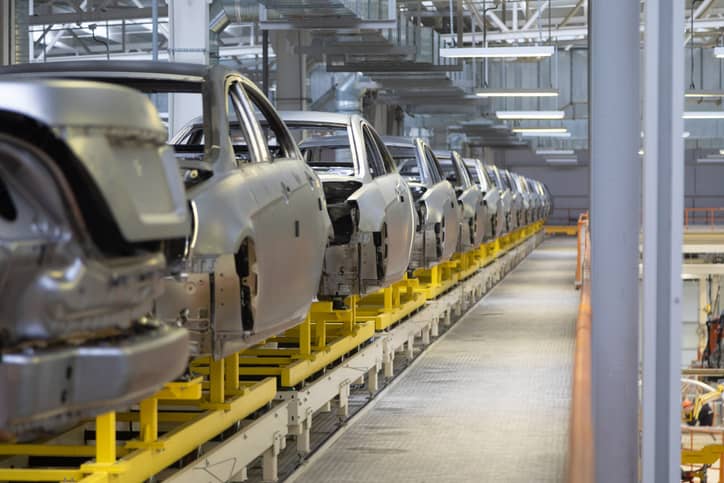The Road to 2030
What is the Detroit Region’s Future Technology Mobility Study & Road to 2030?
The Global Epicenter of Mobility commissioned a study to chart the next wave of mobility technology innovation shaping the Detroit Region’s economy. The Future Mobility Technology Study was developed by S&P Global Mobility for the Detroit Regional Partnership’s Global Epicenter of Mobility initiative.
Guided by our strong automotive heritage to leverage non-light vehicle opportunities, the study identifies high-growth mobility technologies that will shape the Detroit Region’s advanced mobility industry cluster over the next 5 to 7 years.
The Road to 2030 initiative takes these findings and provides additional data and insights to help guide strategic efforts in business attraction, help identify growth and expansion opportunities, support entrepreneurship, and prepare talent, all while strengthening the region’s leadership as the Global Epicenter of Mobility.
What are the seven advanced mobility technologies identified to help accelerate the Detroit Region’s mobility future?
Hydrogen Fuel Cell Systems
Hydrogen fuel-cell systems generate electricity by combining hydrogen with oxygen, producing water as the only byproduct. This powers an electric motor in hydrogen-fuel cell vehicles, offering a clean, efficient, and zero-emission alternative to traditional engines.
Propulsion Batteries
High-capacity batteries powering electric vehicles (EVs), enabling movement without the need for an external fuel source.
E-Motors
E-motors convert electrical energy into mechanical motion, propelling hybrid and electric vehicles.
Power Electronics & Integration
Power electronics in EVs manage and control the flow of electrical energy between the battery and the motor. They include inverters, converters, chargers, controllers, power distribution units, and voltage regulation, which are essential for acceleration, charging, and vehicle performance.
Thermal Efficiency Systems
Propulsion thermal management systems are designed to keep EV components, such as the battery and motor, at safe operating temperatures. They help hybrid EVs run more efficiently, last longer, and perform better.
Software-Defined Vehicles, Cybersecurity, & OTA
Software-Defined Vehicles (SDV) rely on software for control and customization, and cybersecurity solutions protect each vehicle’s software and data from threats. Over-the-Air (OTA) updates enable remote software upgrades, keeping vehicles current without the need for a dealership visit.
Assembly Automation
Assembly automation involves using machines, robotics, and software platforms to optimize manufacturing processes in order to improve efficiency, precision, safety, and production speeds.
What are the overarching themes reflected in these seven technologies?

The seven technologies represent a combination of mature and emerging technologies allowing the Detroit Region to capitalize on current market conditions while positioning our future at the forefront of advanced-generation mobility innovation.

The seven technologies all have accelerated growth trajectories with North American compounded annual growth rates in the double digits, indicating robust projected growth regardless of whether the market is mature or emerging.

All seven technologies will leverage the Detroit Region’s automotive heritage and strength to grow adjacent mobility sectors such as medium vehicle, heavy vehicle, maritime, and more.
Growth Opportunities for the Detroit Region
While unit volume is relatively low, hydrogen fuel cells represent some of the highest technology compounded annual growth rates across all non-light vehicles sectors ranging from 75% in medium/heavy duty vehicles to 334% in maritime.
Michigan’s thermal system production is anticipated to grow 85% by 2030 which would account for approximately 10% of the North American production.
Battery is projected to grow along with BEV growth. Anticipated U.S. units produced is anticipated to increase from 1.2 million vehicles to 5.8 million vehicles.
The Detroit Region has the potential to grow its employment base for SDV by 2,700 workers by 2030.
E-motor unit growth is expected to grow by 216.4% in the U.S. with production increasing from 2.5 million units to 7.8 million units per year.
According to Grand View Research, the North American Manufacturing Automation market is expected to grow at a compounded annual growth rate of 8.5% between 2025 and 2030.
Michigan’s inverter production is forecasted to reach 20% of the total North American demand by 2035.
How will this study help GEM and its partners achieve strategic growth in the Detroit Region?
- Business Attraction & Retention: Identifies high-growth technology areas that will guide a regional attraction strategy and guide retention strategies to ensure companies within the region remain competitive.
- Legacy Industry Transition: Highlights pathways for traditional automotive and manufacturing companies to pivot toward next-generation technologies such as hydrogen fuel systems, battery innovations, and automation.
- Innovation & Entrepreneurship: Pinpoints white-space opportunities where startups and scale-ups can lead innovation—especially in SDV software, hydrogen fueling infrastructure, and integrated thermal management systems—positioning the region as a launchpad for breakthrough mobility solutions.
- Testing & Validation: Provide insights to the Detroit Region’s testing facilities to prepare testing infrastructure that companies will need to prove out new technologies.
- Talent Strategy Alignment: Informs the regional workforce and education study currently underway that will identify key occupations and credentials in highest demand.
- Regional Differentiation: Frames the Detroit Region’s opportunity to lead in sectors where mature and nascent technologies intersect, leveraging a deep legacy in vehicle production with emerging dominance in electrification, autonomy, and clean propulsion that expands into adjacent mobility sectors.
Looking to learn more?
Contact the DRP Research Team:
Bernard Swiecki
Vice President of Mobility and Research
Global Epicenter of Mobility
 Go to DetroitRegionalPartnership.com
Go to DetroitRegionalPartnership.com